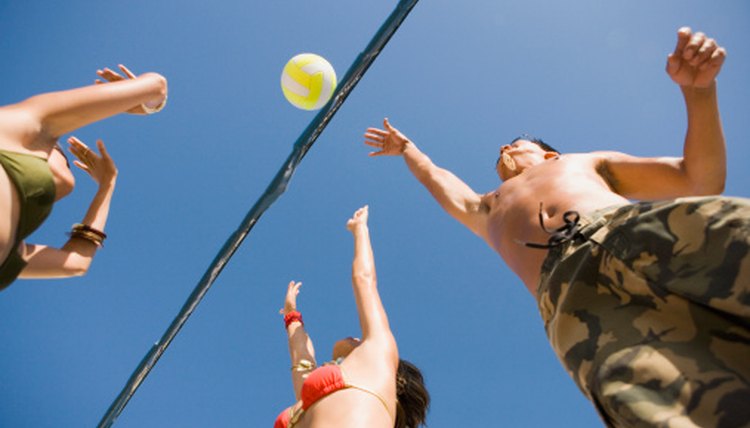How to Get Over a 30 Inch Vertical Jump

Success in many athletic competitions is predicated upon the ability to jump high. Not only is height paramount, but how quickly that individual can jump high, as well. The key to developing and improving vertical jump is the concept of applying maximal force rapidly. Power training, by way of plyometrics and weight training, is an effective method to improve your vertical jump. Plyometrics is a type of training that involves explosive jumping exercises. Weight training for the lower body using squats with timed repetitions, in conjunction with plyometric training, expedites the time needed to improve your vertical jump.
Perform front box jumps. Stand in front of a 12-inch box. Execute countermove by bending at the hips and knees then explode onto the box. Land softly into a squat with both feet placed in the center of the box. Step down one foot at a time and repeat. Perform three sets of 10 repetitions at this height. Incorporate plyometric jumps twice a week. Progress to higher box jumps each week or when physically capable.
Incorporate parallel or back squats into your training three times per week. Stand with your back to a barbell that is sitting on a rack. Ensure that the barbell is resting approximately shoulder height. Lift the barbell to rest on your shoulders. Lower your body by bending at the hips and knees until you reach the point where your thighs are parallel to the floor. Press your heels into the floor and return to the starting position. Use a weight that is roughly 60 percent of your body weight. Attempt to do five reps in five seconds. Repeat for five sets.
Combine both plyometrics and weight training by incorporating squat jumps. Stand with your feet hip-width apart. Hold a dumbbell in both hands at your sides. Dip down into a squat position and explosively extend your hips and knees, jumping as high as possible. Land into a squat position and repeat. Perform three sets of 8 reps. Increase resistance periodically to ensure progress.
References
- "Jumping Into Plyometrics, second edition"; Donald A. Chu; 1998
- "Effect of Potentiating Exercise Volume on Vertical Jump Parameters in Recreationally Trained Men"; Khamoui, AV et al; the Journal of Strength and Conditioning Research, Vol. 23, Number 5: pgs. 1465 to 1468; 2009
- Sáez de Villarreal E, Requena B, Cronin JB. The Effects of Plyometric Training on Sprint Performance: A Meta-Analysis. J Strength Cond Res. 2012 Feb;26(2):575-84. doi:10.1519/JSC.0b013e318220fd03
- Johnson BA, Salzberg CL, Stevenson DA. A Systematic Review: Plyometric Training Programs for Young Children. J Strength Cond Res. 2011 Sep;25(9):2623-33. doi:10.1519/JSC.0b013e318204caa0
- Domire ZJ, Challis JH. Maximum Height and Minimum Time Vertical Jumping. J Biomech. 2015 Aug 20;48(11):2865-70. doi: 10.1016/j.jbiomech.2015.04.021. Epub 2015 Apr 22.
- Johnson BA, Salzberg CL, Stevenson DA. A Systematic Review: Plyometric Training Programs for Young Children. J Strength Cond Res. 2011 Sep;25(9):2623-33. doi: 10.1519/JSC.0b013e318204caa0.
- Maćkała K, Fostiak M. Acute Effects of Plyometric Intervention—Performance Improvement and Related Changes in Sprinting Gait Variability. J Strength Cond Res. 2015 Jul;29(7):1956-65. doi: 10.1519/JSC.0000000000000853.
- Sáez de Villarreal E, Requena B, Cronin JB. The Effects of Plyometric Training on Sprint Performance: A Meta-Analysis. J Strength Cond Res. 2012 Feb;26(2):575-84. doi: 10.1519/JSC.0b013e318220fd03.
Writer Bio
Everett Callaway has been a writer and fitness trainer for more than 20 years, focusing on health, fitness and exercise topics. He earned his B.S. in sports and fitness from the University of Central Florida. Callaway is a personal-training instructor, a certified strength-and-conditioning specialist and holds several other industry certifications.
